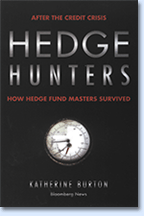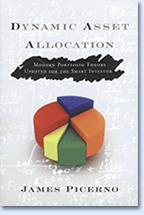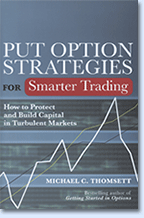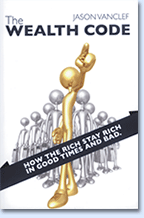Books For Traders
July 2010
- Hedge Hunters: 2009 Edition
- The Mutual Funds Book: How To Invest In Mutual Funds & Earn High Rates Of Return Safely
- Dynamic Asset Allocation: Modern Portfolio Theory Updated For the Smart Investor
- Put Option Strategies For Smarter Trading
- The Wealth Code: How The Rich Stay Rich In Good Times And Bad
- Winning Spread Betting Strategies
Return to Contents

![]() Hedge Hunters: 2009 Edition
Hedge Hunters: 2009 Edition
(244 pages, $16.95 paperback, 2010, ISBN 978-1-57660-363-5) by Katherine Burton, published by Bloomberg Press.
Since the first edition of this book came out in 2007, the financial markets have been turned upside down. The new preface of this edition explores the changes that the credit crisis has brought to the markets. Each chapter has been updated to show how the fund was affected by the downturn, how it is coping with the turbulence, and how it survived. Even though the original edition came out at the top of the market, many lessons can be learned from reading this updated version. Only three of the 17 managers originally profiled made money. Managers who commented on their experience see things in different ways, but no one expects hedge funds to go away.
Additional information: www.bloomberg.com/books
BACK TO LIST

![]() The Mutual Funds Book: How To Invest In Mutual Funds & Earn High Rates Of Return Safely
The Mutual Funds Book: How To Invest In Mutual Funds & Earn High Rates Of Return Safely
(288 pages, $24.95 paperback, 2009, ISBN 978-1-60138-001-2) by Alan Northcott, published by Atlantic Publishing Group.
This guide explains the basics of mutual fund investing in an easy-to-read format. You will learn how they work, what factors need to be considered before investing, and how to avoid common pitfalls. You will understand the types of funds and the jargon that will put you in control of your money. This book will help you to become your own fund manager, or at least rest easier because you understand the fund manager as well as the fund.
Additional information: www.atlantic-pub.com
BACK TO LIST

![]() Dynamic Asset Allocation: Modern Portfolio Theory Updated For the Smart Investor
Dynamic Asset Allocation: Modern Portfolio Theory Updated For the Smart Investor
(274 pages, $29.95 hardcover, 2010, ISBN 978-1-57660-359-8) by James Picerno, published by Bloomberg Press.
This work lays out a prudent approach for dynamically managing asset allocation, an investing approach that can and should be distinguished from the speculation of market timing. Understanding this distinction and what it implies is critical. The focus is on how the design and management of asset allocation has evolved and why investors need to understand and act accordingly. The author’s view is that buying and holding is a mistake, one that investors cannot afford to make any longer. This is a presentation of the argument for active asset allocation, which is not market timing.
Additional information: www.wiley.com, www.bloomberg.com/books
BACK TO LIST

![]() Put Option Strategies For Smarter Trading
Put Option Strategies For Smarter Trading
(223 pages, $27.99 hardcover, 2010, ISBN 978-0-13-701290-9) by Michael C. Thomsett, from Pearson Education publishing as FT Press.
During the 2008 stock market crash, thousands of investors suffered massive losses they could have avoided through careful, defensive use of strategies based on put options. This is a guide to using puts to create profits, protect stock positions, hedge against risk, and regain control of your portfolio. The techniques in this book are indispensable for investors concerned about potential market declines or volatility. Dozens of tables, figures, graphs, and examples are presented clearly and simply for understanding and use. This is a guide to puts that any option trader can apply, regardless of experience.
Additional information: www.ftpress.com
BACK TO LIST

![]() The Wealth Code: How The Rich Stay Rich In Good Times And Bad
The Wealth Code: How The Rich Stay Rich In Good Times And Bad
(176 pages, $15.99 paperback, 2009, ISBN 9781439254479) by Jason Vanclef, published by BookSurge.com.
The author of this book predicts that, for our economy, the worst is yet to come. This book is an effort to help others create smart financial plans that can protect their assets in any economic climate. It is Jason Vanclef’s belief that true asset class diversification is the best way to build a solid financial base. He explains how to invest in real estate, oil and gas, gold, timber, and more traditional investment options. He also discusses why the wealthy don’t keep their money tied to Wall Street. The recent economic crisis in the United States has created a growing need to take a closer look at asset allocation, and the importance of investors educating themselves about the variety of investment options available.
Additional information: www.booksurge.com
BACK TO LIST

![]() Winning Spread Betting Strategies
Winning Spread Betting Strategies
(215 pages, £24.99 paperback, 2009, ISBN 978-1906659103) by Malcolm Pryor, published by Harriman House Ltd.
In this book, seven strategies are presented covering all types of market; up, down and sideways. The strategies are used on a wide range of instruments; stocks, commodities, and currencies, and the trade duration tends to be in weeks. Examples of each strategy are fully illustrated with charts and commentary — there are more than 150 charts in this book — taking the reader step by step through strategy implementation.
Additional information: www.harriman-house.com
BACK TO LIST